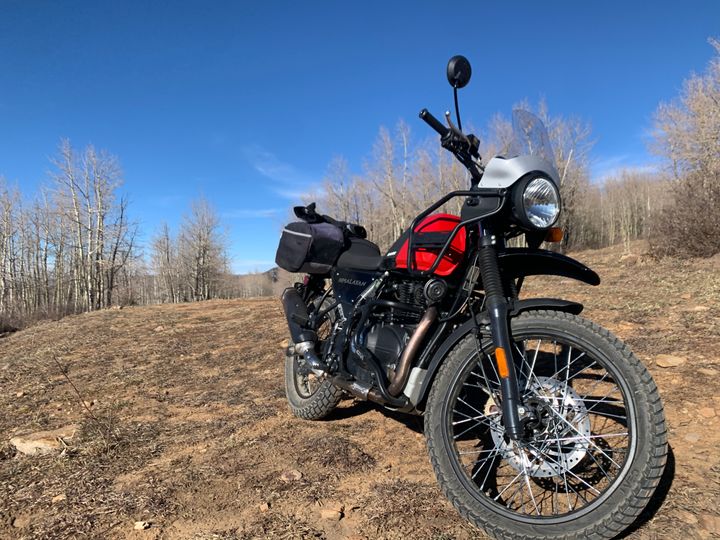Pre-Ride Safety Check
A pre-ride checklist is as important as assuming a firearm is loaded. Check before use.


As Important as Assuming a Firearm is Loaded
When is it safe to assume that motorcycle is safe? About as often as you assume a gun is unloaded. Never. Now, that may sound a bit dramatic, but hear me out. I happen to have a personal story that relates to the question of assuming a motorcycle is safe. The good news is that neither I nor anyone else was hurt during this incident, but it sure made me realize I can only confirm what I have verified. If you would rather watch than read, click here or go to bottom of page ⏬️.
As I rode home from the dealership in Durango, Co, Durango Harley, I realized my brand new Royal Enfield Himalayan was a bit wobbly on the turns compared to the Softail Deluxe I had just traded in. It has been a long, long time since I have ridden anything that did not weigh over 600lbs and that is what I attributed the wobbliness to.
After 45 miles and a smallish mountain pass, I arrived home and did what any motorcycle enthusiast does, I began to tinker with it. The first thing I looked at was the rear wheel since it had a chain and I had come from a belt. I noticed the marks on each side were not exactly aligned. It wasn't off by much, but it the alignment was not 100%. So, I aligned the wheel which in turn took care of the wobble. For the record, I still love Durango Harley because of how they took care of me and other customers I have seen. No one is perfect.
Now, that was a new motorcycle. If you were going to assume the bike is safe, that is most likely the time it will happen.

Used Motorcycle Purchase
See that rider up there! WOW! That is amazing...
Who is to say that the used motorcycle you are about to go look at for sale was not the bottom half of that duo last weekend? People prefer to purchase new bikes for this very reason. At least they know the bike has not been party to that!
So, when you DO go for that investigative visit before purchase, what can keep you focused on the facts while your heart races at the sight of what will most likely be a very well shined up used motorcycle? I'm glad you asked! It is the exact same thing that will keep you safe riding your motorcycle week after week.
The above downloadable for is linked to the Motorcycle Safety Foundation's webpage. Not only is it a thorough pre-ride checklist, but also a great guide for purchasing a used vehicle (And even taking delivery of a new one). The checklist is just that. It has the description of what to check along with what to look out for. We will go through what I found on my motorcycle next. Oh yeah, my adventure bike only had 400 miles on it, AND, I found some issues!
T-CLOCS Inspection Checklist
T-Tires & Wheels
This section was clear for me since I had already found the misaligned wheel 400 miles ago. The other checks are for the tires, wheels and brakes. All was good.
C-Controls
Not sure why hoses are a part of the controls section, but the other places to check are handlebars, levers and pedal, cables, hoses and throttle.
Ahaha! Two issues discovered on a bike with 400 miles on it. I know I already said that, but it still blows my mind away. One issue found while checking the Cables while the other was found while checking Hoses.

The clutch cable adjuster sleeve on my Royal Enfield Himalayan had a loose nut on one end. I found out later when I actually started it to make sure it was adjusted that is was not. Yes, it is an easy adjustment even on the trail with the most basic tools, but, the bike was not ready. Nothing worse than getting all geared and gloved up only to find that the engine won't start due to the transmission engaging because the clutch is not adjusted properly. At least is sure would have frustrated me. I imagine if I was riding with a group of adventure motorcyclists, the need for everyone to be ready to roll is paramount.

This one is a bit more serious than anything else I found during the pre-ride checklist. The fact that I found oil on the banjo bolt and back of the hose when I ran my hand down was a little disturbing (considering mileage). Luckily that is what factory warranties are for. It turned out that is a common issue for this model adventure motorcycle. I tightened it a bit and no more leak. But, there was a moment when I was actually concerned 😣.
L-Lights & Electronics
In this section, we are directed to check the battery, headlight, tail light/brake light, turn signals (Finally replaced the broken one), switches, mirrors, lenses/reflectors and wiring.
Aaaaand, here is the other section within which I found an issue. If you look on the checklist halfway through the section you see "Tail lamp/brake lamp." I checked the operation of each and found that both the tail light. and brake light worked as required. No problem. But, when I happened to touch the tail light fixture, it moved. Turns out I never secured it back down fully when I installed the Royal Enfield Pannier Rack on the bike a week earlier. Wow!

The bike would not have gone off the road because it completely wobbled loose, but I would prefer not to have to buy a new tail light. First attempt at a GIF. What do ya think? Anyway, checklist to save the day.
O-Oil & Other Fluids
Here we check for levels and leaks for the fluids on the bike. Having an air-cooled motorcycle means there are less fluids to check. Thankfully, this section was good even though I am just in the range for the first oil change and valve adjustment. Good for now.
C-Chassis
Next, inspect the frame, suspension, chain or belt and fasteners. This section includes a lot of componets that take a lot of wear from the riding style you employ. For those of us with adventure bikes that spend a lot of time off-road motorcycling, its even more urgent.
S-Stands
The last section is for what holds the bike up; both the center stand and side stand. Keep in mind this one is not just for holding your bike up when you are not riding it. The real safety concern is that the stand may not remain securely in the locked "up" position and cause the bike to "stand" up when you are riding. THAT is a bad situation. Many people have had serious injuries for their stands. That is why nowadays the engine cuts off when the stand is down and the motorcycle is put into gear.

Wrap Up
Safety on the bike is the thing that takes what is fun now and exponentially adds to it by continuing to operate the bike as intended. It also keeps you safe and free from injury and operating as intended as well! It seems like it is a lot to check, and, you're right! It is. And, it will take you a bit to get through the list the first few times. But creating a safe habit works out best for everyone. I know I want my kids that are motorcycling age to see me practice safety just like when I taught them how to safely shoot firearms. Don't forget to check out the video to see what I found while I walked through the checklist. Also, if you would like to be informed of articles first, you are welcome to click the link below and become an Adventurer as well!
Stay Safe!
Ron







Comments ()